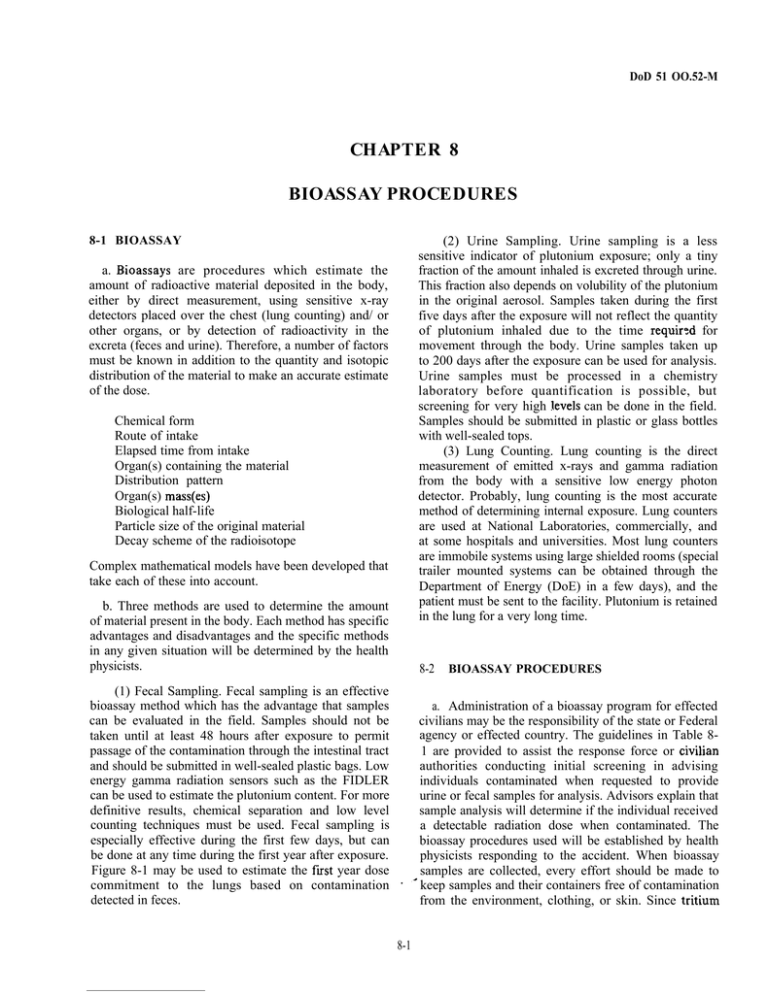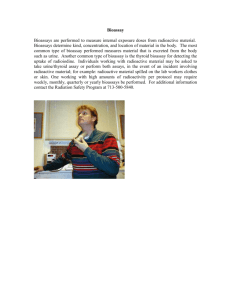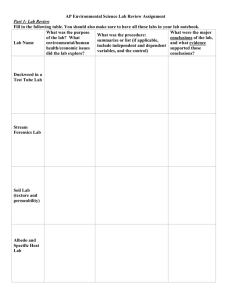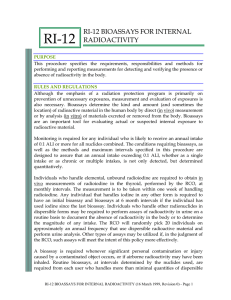CHAPTER 8 BIOASSAY PROCEDURES
advertisement

DoD 51 OO.52-M CHAPTER 8 BIOASSAY PROCEDURES 8-1 BIOASSAY (2) Urine Sampling. Urine sampling is a less sensitive indicator of plutonium exposure; only a tiny fraction of the amount inhaled is excreted through urine. This fraction also depends on volubility of the plutonium in the original aerosol. Samples taken during the first five days after the exposure will not reflect the quantity of plutonium inhaled due to the time requir:d for movement through the body. Urine samples taken up to 200 days after the exposure can be used for analysis. Urine samples must be processed in a chemistry laboratory before quantification is possible, but screening for very high levels can be done in the field. Samples should be submitted in plastic or glass bottles with well-sealed tops. (3) Lung Counting. Lung counting is the direct measurement of emitted x-rays and gamma radiation from the body with a sensitive low energy photon detector. Probably, lung counting is the most accurate method of determining internal exposure. Lung counters are used at National Laboratories, commercially, and at some hospitals and universities. Most lung counters are immobile systems using large shielded rooms (special trailer mounted systems can be obtained through the Department of Energy (DoE) in a few days), and the patient must be sent to the facility. Plutonium is retained in the lung for a very long time. a. Bioassays are procedures which estimate the amount of radioactive material deposited in the body, either by direct measurement, using sensitive x-ray detectors placed over the chest (lung counting) and/ or other organs, or by detection of radioactivity in the excreta (feces and urine). Therefore, a number of factors must be known in addition to the quantity and isotopic distribution of the material to make an accurate estimate of the dose. Chemical form Route of intake Elapsed time from intake Organ(s) containing the material Distribution pattern Organ(s) mass(es) Biological half-life Particle size of the original material Decay scheme of the radioisotope Complex mathematical models have been developed that take each of these into account. b. Three methods are used to determine the amount of material present in the body. Each method has specific advantages and disadvantages and the specific methods in any given situation will be determined by the health physicists. 8-2 BIOASSAY PROCEDURES (1) Fecal Sampling. Fecal sampling is an effective bioassay method which has the advantage that samples a. Administration of a bioassay program for effected can be evaluated in the field. Samples should not be civilians may be the responsibility of the state or Federal agency or effected country. The guidelines in Table 8taken until at least 48 hours after exposure to permit passage of the contamination through the intestinal tract 1 are provided to assist the response force or civiiian and should be submitted in well-sealed plastic bags. Low authorities conducting initial screening in advising energy gamma radiation sensors such as the FIDLER individuals contaminated when requested to provide can be used to estimate the plutonium content. For more urine or fecal samples for analysis. Advisors explain that definitive results, chemical separation and low level sample analysis will determine if the individual received counting techniques must be used. Fecal sampling is a detectable radiation dose when contaminated. The especially effective during the first few days, but can bioassay procedures used will be established by health be done at any time during the first year after exposure. physicists responding to the accident. When bioassay Figure 8-1 may be used to estimate the frst year dose samples are collected, every effort should be made to .commitment to the lungs based on contamination keep samples and their containers free of contamination detected in feces. from the environment, clothing, or skin. Since tritium 8-1 — FIRST YEAR DOSE COMMITMENT TO LUNG r-—--’ ‘ ‘ ‘ ‘ ‘– 1 I FCCAL .wmrs, s INTAKE ASSUMPTIONS L.JEAPONS GRAOE P L U T O N I U M Am-at IWJRITY 1200 pm. PARTICLE SIZE 3.0 W-l AMAO 25X U VOLUBILITY CLASS 75X Y VOLUBILITY CLASS OTHER ASSUMPTIONS ICRP-30 METABOLIC MOOEL DOSE CALCULATED FOR MINIMUM DETECTABLE LEVEL (MDLI fN BIOASSAY MOL FOR URINE ANALYS[S = O 095 PC1 /SAMPLE MOL FOR FECAL ANALYSIS = O 95 PCI/SAMPLE MOL FOR IN-VIVO LUNG COUNT = 500 PC I AM-2+1 OUAL 1 TY FACTOR FOR ALPHA = ?0 I 5 1 1 15 10 T ME OF 1 1 20 25 1 30 1 35 1 I 40 95 50 S A M P L E (DAYS A F T E R I N T A K E ) Use ofChart. 1. Enter chart with the time ofsample. 2. Draw vertical line tocumefor sample type. 3. Draw horizontal iineto Dose Equivalent scale. 4. Divide thevalueobtained from theDose Equivalent scalebytheMDL for the sample type and multipiy this vahreby the contamination level of thesrsmple inpicocuries to get theestimatedfust year dose to the lung. Example: Measurement ofafecd nmpletaken 5daystiter theaccident read lOOO~i. 1. Steps 1-3 give a Dose Equivalent Scale value of 4 x 10 . -4 2. 3. TheMDLforfecal samplesis.45pCi. 4 x 10-4 x 1000= .889 rem (The estimated fust year dose to the lung.) . 4 5 Andy@ ofawmple taken from themmeperson (mmefirst yeadow) 10daysafter theaccident would beexpected to read only 20 ~i, assuming the individual inhafed contamination only on the day of the accident. .- Figure 8-1. Estimated First-Year Dose Commitment to the Lungs. TABLE 8-1. Guidelines for Bioassay Sampling. Suspected Radioactive Material Plutonium Uranium Tritium Feces Optimum Sampling Time After Exposure Urine Optimum Sampling Time After Exposure 2 days 2-3 weeks 24 hours 4-8 hours 2 days N/A contamination cannot be detected by CCS monitoring, anyone suspected of having been exposed to tritium should follow the guidelines in Table 8-1. A bioassay program is recommended for all individuals without respiratory protection and found to be contaminated. This program will determine if any dose was received and provides assurance to those who did not receive a dose that their health was not effected. To provide similar assurance to all people in the contaminated area, bioassays may be appropriate even for people who weren’t found to be contaminated; moreover, some people never in contaminated areas will request tests to ensure they were not effected by the accident. Sample @.?!@l! 24 hours total 24 hours total 1 voiding . results of both alpha meter screening and bioassays. Use of the Radiation Health History and Bioassay Screening Forms contained in Appendix 5-E should be considered. (2) Nasal Smears. If initial alpha meter screening indicates probable plutonium inhalation, a nasal smear shall be collected for analysis by specialized teams when they arrive on-site. Contamination on a wipe (Q-Tip) from inside the nasal passage is a possible indicator of plutonium inhalation. Due to the biological half-life of nasal mucus, a nasal smear is a reliable indicator only if collected during the first hour after t he exposure. When medical personnel collect nasal smears, the Q-tip must be free from any gels or other material that will prohibit alpha particle counting. (1) Bioassay Priorities. If a nuclear weapon accident occurs near a populated area, obtaining bioassay samples from large numbers of people may be necessary. b. Personnel Exposure and Bioassay Records. Documentation should be maintained on all personnel who enter the radiological control area, or who may have been contaminated prior to establishment of a radiological control area. Examples of forms used for recording data on personnel working in the radiological control area, or who may have been exposed to contamination downwind from the accident, are contained in Appendix 5-E. To ensure appropriate follow-up actions are completed on all exposed, or potentially exposed people, a copy of all CCS logs, other processing station records, bioassay data, and other documentation identifying people who were or were not contaminated should be provided to the Joint Hazard Evaluation Center for consolidation into a single data file. This data file is subject to Privacy Act regulations, and must be retained as part of the permanent accident records. Therefore, procedures for handling data obtained on non-DoD personnel should be coordinated with the OSC’S legal officer. Data obtained on DoD personnel will be needed to satisfy Service-specific requirements contained in AR 40-14, Control and Recording Procedures for Occupational Exposure to Ionizing Radiation; NAVMED P-5055, Radiation Health Protection Manual; AFR 161-8, Control and Recording Procedures Occupational Exposure to Ionizing Radiation; AFR 161-28, Personnel Dosimetry Program and the USAF Master Radiation Exposure Registry, references (q), (r), (s), and (t). These records - shall be retained and become part of the individual’s permanent medical record. NOTE: Since it is virtually impossible for a significant amount of plutonium to be incorporated into the body without gross contamination of skin or clothing also occurring, initial alpha monitoring which identifies contaminated personnel also can provide a method for assuring that those with the greatest possibility of radiation exposures which may affect their health are given priority treatment. Table 8-2, applicable only to people not wearing respiratory protection, provides recommended guidelines for the assignment of priorities for bioassay analysis. Response force personnel will normally be equipped with protective clothing and respirators, when required. Bioassays for response force personnel will be performed in accordance with Service regulations and as directed by the On-Scene Commander. Personnel falling in the HI priority category in Table 8-2 may have had a substantial plutonium intake. Conversely, exposure to airborne contamination which produces a surface contamination level in the LO category will be less likely to result in a significant deposition in the lungs, To ensure alpha meter readings provide a valid guide for assignment of priorities, individuals should be asked, during screening, if they have bathed or changed clothes since the time of possible contamination. A record must be made and retained for future reference of all personnel screened and the 8-3 TABLE 8-2. Guidelines for Assignment of Priorities for Collection and Processing of Bioassays. Alpha Contamination Level on Clothing or Skin E!@.@ 60 cmz probe 17 cmz probe HI Above 300,000 Cpm 50,000-300,000 cpm Above 75,000 Cpm 12,500-75,000 cpm Below 12,500 cpm MED LO Below 50,000 cpm 8-4







